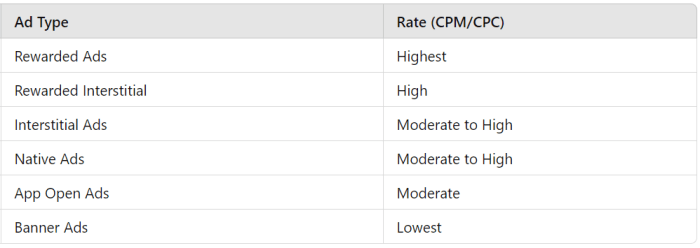Understanding CPC and CPM dives into the world of online advertising metrics, shedding light on the intricacies of cost-per-click and cost per mille models. Get ready to explore the dynamic landscape of digital marketing with a modern twist!
In this discussion, we’ll unravel the mysteries behind CPC and CPM, comparing and contrasting their roles in the ever-evolving realm of online advertising.
Understanding CPC and CPM

CPC (Cost Per Click) is a digital marketing model where advertisers pay a fee each time their ad is clicked on. It is calculated by dividing the total cost of the ad campaign by the number of clicks generated.
CPM in Online Advertising
CPM (Cost Per Mille) refers to the cost per thousand impressions in online advertising. It is significant as it helps advertisers understand how much they are paying for every thousand views of their ad.
Comparison of CPC and CPM Models
- CPC is more performance-based as advertisers only pay when a user interacts with the ad by clicking on it, while CPM focuses on the number of impressions regardless of clicks.
- CPC is beneficial for direct response campaigns where the goal is to drive clicks and conversions, while CPM is better suited for brand awareness campaigns aiming to reach a wider audience.
- CPC allows advertisers to track the effectiveness of their ads more accurately through metrics like click-through rate, while CPM provides broader visibility but may not guarantee engagement.
CPC vs. CPM

In the world of online advertising, understanding the differences between CPC (Cost Per Click) and CPM (Cost Per Mille) is crucial for businesses looking to maximize their ad spend efficiently. Let’s delve deeper into when each pricing model is more beneficial and the impact of targeting and ad placement on their effectiveness.
When CPC is More Beneficial Than CPM
- In industries where the conversion rate is high and the goal is to drive direct actions, such as e-commerce or lead generation, CPC tends to be more beneficial. Businesses pay only when a user clicks on their ad, making it a cost-effective option for driving immediate results.
- For campaigns focused on specific s or high-intent audiences, CPC allows advertisers to target and optimize their ads for maximum engagement, ensuring that every click has the potential to convert into a valuable action.
Industries with Higher CPM Rates
- Highly competitive industries like finance, real estate, and luxury goods often have higher CPM rates due to the premium nature of their target audience and the value of each impression. Advertisers in these sectors are willing to pay more to reach a select group of users.
- Branding campaigns that prioritize visibility and brand awareness over immediate conversions often opt for CPM pricing, as they aim to maximize the reach and frequency of their ads to create lasting impressions on the target audience.
Impact of Targeting and Ad Placement
- Effective targeting strategies can significantly impact the performance of both CPC and CPM campaigns. By reaching the right audience with relevant messaging, advertisers can increase click-through rates for CPC ads and improve engagement metrics for CPM ads.
- Strategic ad placement plays a crucial role in determining the success of CPC and CPM campaigns. Placing ads on high-traffic websites, relevant platforms, or at key moments in the customer journey can enhance visibility and drive better results, regardless of the pricing model chosen.
Factors affecting CPC and CPM: Understanding CPC And CPM
When it comes to understanding CPC and CPM, there are several key factors that can influence these advertising metrics. Let’s delve into the elements that impact CPC rates and CPM pricing.
Ad Relevance
One crucial factor that affects CPM pricing is the relevance of the ads being displayed. Ads that are more relevant to the target audience are likely to have higher engagement rates, leading to better CPM pricing.
Competition
The level of competition in the advertising space plays a significant role in determining both CPC and CPM costs. High competition for ad placements can drive up prices, while less competition may result in more cost-effective advertising rates.
Optimizing CPC and CPM
To maximize the effectiveness of your ad campaigns, it’s crucial to optimize both your CPC and CPM strategies. By focusing on improving your CPC performance and targeting the right audience for CPM, you can ensure that your advertising efforts are reaching the right people and generating the best results.
Strategies to Improve CPC Performance
- Utilize relevant s: Ensure that your ad content includes s that are highly relevant to your target audience, increasing the chances of clicks.
- Optimize landing pages: Create engaging and user-friendly landing pages that are closely aligned with your ad content to improve conversion rates.
- Test ad copy: Experiment with different ad copy variations to see which ones resonate best with your audience and drive higher click-through rates.
- Monitor performance: Regularly analyze the performance of your ads to identify areas for improvement and make necessary adjustments.
Optimizing CPM by Targeting the Right Audience, Understanding CPC and CPM
- Define your target audience: Clearly identify your target audience based on demographics, interests, and behaviors to ensure your ads are being shown to the right people.
- Utilize audience segmentation: Segment your audience based on different criteria to deliver more personalized and relevant ads, increasing the chances of engagement.
- Use retargeting techniques: Implement retargeting strategies to reach users who have previously interacted with your ads or visited your website, increasing conversion rates.
Importance of A/B Testing in Refining CPC and CPM Strategies
- Compare ad variations: Conduct A/B tests to compare different ad variations and determine which ones perform better in terms of CPC and CPM.
- Optimize based on data: Use the insights gathered from A/B testing to make data-driven decisions on how to refine your CPC and CPM strategies for better results.
- Continuous testing: Regularly test new ideas and strategies to stay ahead of the competition and continuously improve the performance of your ad campaigns.












